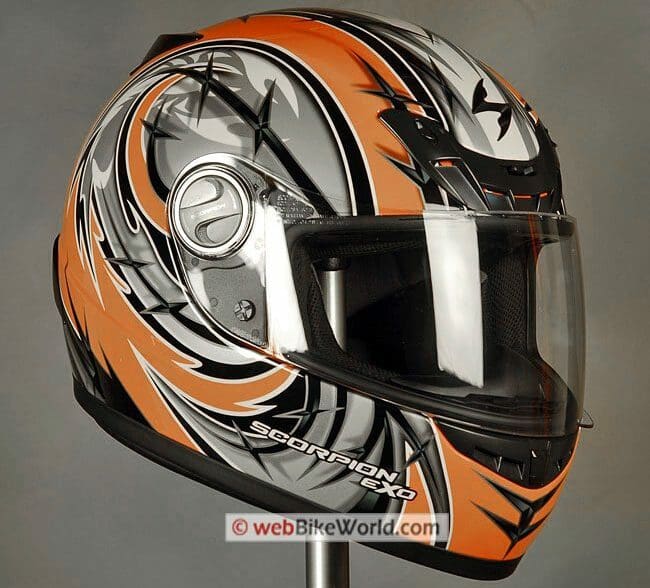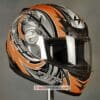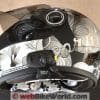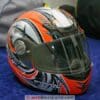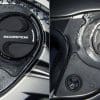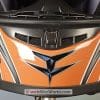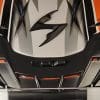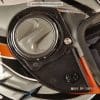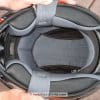Bargain helmet with quality features, very nice graphics and paint and a few quirks. Heavy, but doesn’t feel it.
Probably one of the highest quality helmets currently available at this price point.
What’s a more polite term for “bottom of the line”?
I guess I could say that the EXO-400 is Scorpion’s “entry level” full-face helmet, but that term might also be a turn-off for some.
Maybe I could say that the EXO-400 is the anchor of the Scorpion helmet lineup? Nah, that’s silly.
The problem is that Scorpion makes some pretty nice helmets.
And the EXO-400, occupying the, uh, bottom of the ladder, is probably better than the best helmets made by several other companies.
We’re still waiting for an EXO-1000 to review, but it’s obvious from the numbering scheme alone that it will be the top-of-the-line Scorpion offering, at least in the foreseeable future.
We reviewed the Scorpion EXO-700 (review) in December of 2004 when the helmet was released to dealers; that was Scorpion’s first full-face helmet effort and it was — and still is — a good one.
I haven’t tried a new EXO-700, but the EXO-400 shown here is just about equal to the EXO-700, in my humble opinion anyway.
The 400 yields an aura of solidity and quality right out of the box, unlike a lot of other helmets I can think of for the $149.95 asking price (list).
The EXO-400 uses an “Advanced Polycarbonate Composite Engineered Shell”, and since some riders prefer the relative softness and “crushability” of polycarbonate anyway, that’s not a bother.
The chin bar is lined with EPS (expanded polystyrene), which is also supposed to make a difference, but it feels like pretty hard stuff to me.
It just doesn’t feel or look like any manufacturing or assembly shortcuts were taken on the EXO-400, so the bottom line is that there’s nothing wrong with buying the bottom of the line.
I’m really not sure what the EXO-700 offers that the EXO-400 doesn’t; at least the EXO-1000 supposedly comes with unique features like air-adjustable cheek pads and an internal sun visor (let’s hope it doesn’t add too much weight) to justify the more-than-twice-as-much asking price.
I honestly think that this is a 150-buck helmet that could serve as anyone’s full-time, all-around lid that should last about as long as anything else, providing yeoman service along the way — as long as you can live with its foibles, as you’ll see.
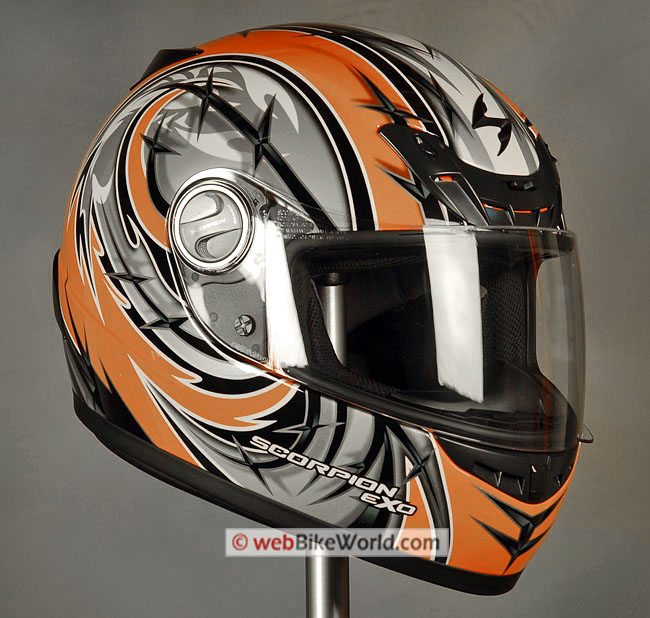
Paint, Graphics and Finish
You can save a sawbuck by buying an EXO-400 in a solid color, but the “Sting” graphics shown here are a nice compliment to the helmet design. Scorpion offers a very large number of color choices in each graphic; the Sting can be had in blue, green, matte silver, silver, orange, red and yellow.
The orange shown here is a real standout — the decals are perfectly applied, they look three-dimensional and the helmet has a nice, thick clear coat that’s been polished to a beautiful shine without a hint of orange peel or captured dust. Very nice.
I did something dumb the very first time I took the helmet outside — I dropped it on the street.
It hit hard but the only damage is a very slight nick through the paint, about 2 mm in diameter. Bad luck but a good sign of quality.
Unlike the first batch of EXO-700’s, I can’t find a thing out of place on the EXO-400 — the gasket around the bottom of the helmet is perfectly attached; the liner is plush and uses quality material; the visor is excellent and the plastic vent assemblies are just so.
Well, maybe there is one thing — the breath guard is slightly loose at either end, but I usually toss these things anyway.
Score: I give the EXO-400 a rating of “Outstanding” for paint, graphics and overall quality, with a slight ding for the breath guard.
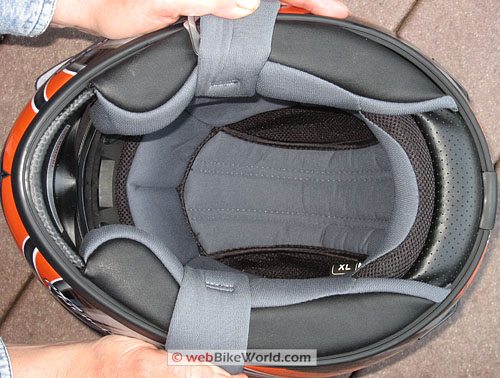
Helmet Fit and Liner
The EXO-400 fits just like the EXO-700. I’d say it’s a moderate round head shape, tending towards neutral. Scorpion played it safe here and I think the helmet should fit a wide variety of owners, except maybe extreme long ovals.
We compared the size XL shown here to other helmets and based on this example, we think the EXO-400 runs about 1 size small. Our XL fits much more like a size L, so plan accordingly.
You may want to try this one on before you buy it, which shouldn’t be a problem because Scorpion seems to have a fairly large distribution in the dealer network.
The helmet liner is claimed to wick moisture. The liner is also removable and washable, as are the cheek pads, and the cheek pads are available in different thicknesses, which is rare at this price point.
And get this — the liner and cheek pads are supposedly available as accessories in “wild colors and patterns”.
Two strange items to note: Our helmet came with a size large liner installed and a size XL liner in a bag inside the helmet box — the first time we’ve ever experienced this.
We installed the XL liner for our evaluation and we’re assuming that the helmet is otherwise identical to an XL.
Also, the liner had a strong chocolate smell that was overpowering when new and is still there after a couple of months. This was interesting/funny at first but quickly became tiresome. I’m not sure if the smell was added at the factory?
Like most of the products we review on webBikeWorld, the helmet was purchased anonymously from a retailer, so we can only assume that the smell is OEM.
In addition to the similarity to the EXO-700 fit, I’d say the EXO-400 fits like the old Shark RSR (not the extreme long oval Shark RSi) and similar to an HJC AC-12 Carbon and very close to the URBAN N20 Astro.
The EXO-400’s thick padding and smooth Nylon-feeling liner material goes a long way, I think, towards making the helmet fit comfortably.
Remember that correct helmet fit is crucial for comfort, safety and noise reduction; see the wBWMotorcycle Helmet FAQ page for more information on finding the right fit for your particular head shape.
Score: It’s hard to rate the fit, but I rate the liner and padding as excellent.
Helmet Weight
We were all shocked to discover that the Scorpion EXO-400 shown here in size XL weighs 1785 grams (3 lbs., 15 oz.), which puts it right up there in Hungry Man territory, along with the heavy hitter flip-ups.
Why shocked? The helmet just doesn’t feel that heavy; we didn’t notice the weight during evaluation trials and it doesn’t seem that heavy when I’m wearing it.
We never weigh a helmet until after the evaluation, saving that step for the last minute, so the statistics won’t bias the report.
We thought something might be wrong with the webBikeWorld Polder scale, but nope — it turns out that the EXO-400 is a bit on the porky side.
But I don’t think it should be a bother, unlike some helmets that feel every bit of their mass. The helmet feels nicely balanced in use.
If I had to guess, I’d say that two features are responsible for the extra avoirdupois: polycarbonate is heavier, all things considered, than fiberglass or carbon fiber matrix.
Also, the EXO-400 meets both DOT and Snell approvals, and, as the saying goes, “Meeting Snell means a thicker shell”.
See the wBW Motorcycle Helmet Weights page for our helmet weight comparison table and chart to get a better idea at how the EXO-400 compares with the 70 other helmets in our database of reviews.
Score: I give the EXO-400’s weight and weight distribution a “Good” rating.
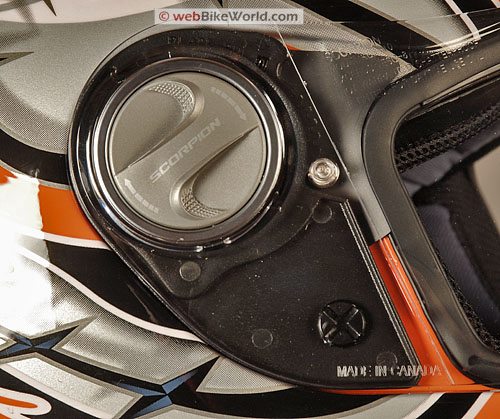
Face Shield
Not much to say here; the face shield on the EXO-400 is about as thick as can be expected for a good quality helmet. It does flex slightly when lifted from one side using the tab.
The tab is molded into the bottom lower left side of the face shield and it’s larger than normal, which is nice.
The lifting mechanism seems tight but only has 5 detents and the first one opens the visor too wide for just a slight defog, which is a disappointment.
The face shield uses Scorpion’s “SpeedShift” removal mechanism, which we still find a bit cumbersome. It’s hard to remove the face shield smoothly; I find that I usually have to mess with the wheel a bit and the post that works against the detent notches is slightly fussy.
The EXO-400 face shield removal and replacement is demonstrated in our video below.
Scorpion claims that the face shield is anti-fog treated on the inside, but we haven’t been able to verify this in our evaluations, due to the recent warm weather. The face shield is also claimed to have an anti-scratch treatment on its exterior.
The face shield does not quite meet the eye port gasket on either side, which is a disappointment.
Score: Face shield quality, clarity, operation and removal/replacement is rated as “Good”.
Helmet Noise
The EXO-400 is schizophrenic when it comes to noise. When it’s worn while riding an unfaired motorcycle, it actually seems to be one of the quieter helmets we’ve tried.
However, when it’s worn behind a small fairing that dumps turbulent air around the lower chin or bottom of the helmet, the EXO-400 can become very noisy indeed. Dropping down behind the windscreen to direct the turbulence to visor height lowers the noise somewhat.
So if you’re riding a motorcycle sans windscreen, you should be fine, but beware if your motorcycle’s fairing dumps “dirty” air at the bottom of your helmet.
I don’t really notice any whistling noises coming from the vent array, but the helmet does seem to have a tendency to vibrate when buffeted or when I’m riding on a bike with a fairing with turbulence and my head turns about 30 degrees from the centerline.
And the helmet does seem to have a stronger than normal draft up under the chin. The plus is that this serves as the helmet’s primary form of ventilation, but the negative is that this causes extra noise.
Note that these comments are valid only when riding with correctly fitted earplugs. See the wBWEarplugs and Hearing Protection page for more information on choosing and wearing earplugs.
Score: So my feeling is that the EXO-400 rates a “Good” if it’s worn on a “naked” bike or behind a full fairing and “Poor” on certain types of fairings or windscreens that dump turbulent air around the bottom of the helmet.
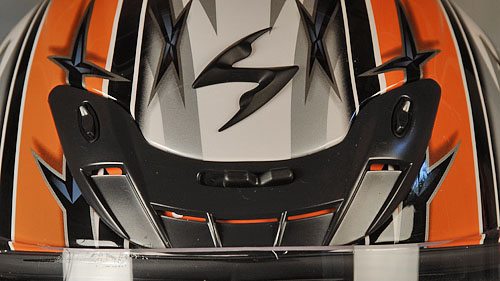
Ventilation
The stylists probably had too much influence on the EXO-400’s venting system, because it sure seems to me that the complex vent array has more vent buttons and levers than are necessary.
The top vent has a horizontal tab that opens or closes the small and narrow top vent. A rocker lever is provided on either side of the top vent to open or close the two vertical vents. All of these are difficult to locate when wearing gloves and they vents don’t really seem to flow much air anyway.
The chin vent is a small vertical on/off switch, but the chin vent openings are narrow and the lack of a vent in back of the chin bar means that what little air comes in is directed up on to the back of the visor.
There are two lower rear exhaust vents and a top exhaust vent that also has an on/off sliding switch, but this vent could have been left permanently open with no problems. Why make things unecessarily complicated?
All this and the vents don’t really seem to flow much air anyway.
Most of the air comes in from up under the chin bar. The liner does not have any visible holes or mesh, so any air that flows in doesn’t seem to flow on to the rider’s head.
Score: I rate the venting system on the EXO-400 as “Poor”.
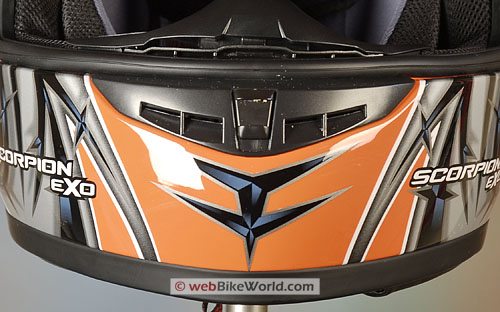
Miscellaneous
The EXO-400 has a D-ring attachment system that includes a fabric pull tab and a snap to secure the extra length of strap.
Conclusion
If you can overlook a few idiosyncrasies, the Scorpion EXO-400 helmet is a bargain. It’s well made, the graphics and paint are very well done and the liner is comfortable (and smells like chocolate!).
The downsides are the inconsistent venting and the noise in certain circumstances.
| wBW Review: Scorpion EXO-400 Helmet | |
|---|---|
| Manufacturer: Scorpion Sports, Inc. | List Price (2007): $139.95-$159.95 |
| Colors: Variety of solids and graphics. | Made In: China |
| Sizes: XS-3XL | Review Date: April 2007 |
|
Rating Scale is subjective: Unacceptable, Poor, Neutral, Very Good, Excellent, Outstanding.
|
|
| Note: Size 3XL is DOT FMVSS 218 only. | |
Owner Comments and Feedback
See details on submitting comments.
From “S.K.” (09/10): “I recently purchased a Scorpion EXO 400 to replace my aging one. T
here are a couple of minor changes, including the chin vent and eye port gasket, but the biggest change is the addition of the one more notch on the visor opening. This allows the much requested “cracking open” of the shield.
The mechanism on the right is from a helmet made during May 2006, while the left is from a helmet made during September 2008. Considering that it is now almost two years later, and this is the first I have heard of it, there is probably a lot of old stock still out there.”
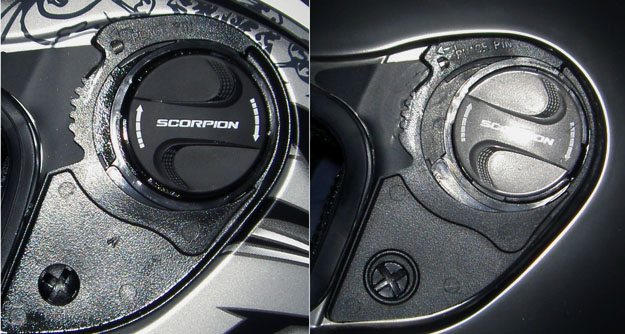
From “FG” (7/10): “I have the Scorpion EXO-400 Spring helmet with a silver visor. I enjoy it very much!
I regularly remove and re-install the visor – initially was having a problem with putting it back on but after looking at the design of the mechanism, it’s a snap to install with no crunching sounds…
The key to re-installing it is to take a good look at the metal posts on either side of the inside of the visor. these slide in behind the concave-C-shaped plastic notch just superior to the ratcheting notches.
Slide the flanged metal posts right into the “C” shaped notch and press the opposite side of the visor area that’s still not seated yet against the helmet and it’s done. When I tried this i found that it was best to do one side at a time.
Women with longer manicured nails will find it more difficult to twist the dials on the visor system to remove the visor. I used a hand-towel to help grip the twist-dials since my nails are fairly long. I had no problem doing it that way.”
From “K.P.” (4/10): “I recently read your Scorpion EXO 400 review. I have to say that your review encompassed all of the negatives that I experience with this helmet from the vents to the visor and noise: very thorough review.
I can’t even see the settings for the vents that slide side to side above the visor. It is very hard to tell if they are open or closed.
I really like the graphics: I have a green EXO and they match my green Kawasaki very well. I’ve gotten many compliments on the helmet looks.
I am however, very disappointed with the noise, vents, and that irritating first notch on the visor because it opens the visor too far for cold weather riding.
In cold weather, I have to continually open and close the visor to reduce the fog then shut out the -32 degree air: I ride all year long.
Recently, I dropped the helmet on the ground and it broke the spoiler on the top back of the helmet. I can’t seem to find one to order even though, it just snaps into the twin vent holes. I guess it gives me a reason to buy a new (better) helmet.”
From “J.D.” (7/09): “There are a couple of things I really don’t like about this helmet. First of all it is very noisy. 99% of the noise comes from the poor upper fit of the visor. If I place my hand over this area the noise disappears. Once again VERY NOISY!
The second area is the fit of the cheek pads – very tight! I will be returning this helmet Monday.”
From “NJW” (1/09): “I have an EXO-400 Dogfight. It is a quiet helmet; much quieter than my GMAX-68S, my Nolan, or my Vega Altura fullface helmets. The paint/finish is superb and the padding is first rate.
I agree with the site’s assessment of the venting: great around the chin bar, so-so on top. I just wear it when it’s cold/temperate and leave the hot weather to my excellent venting GMAX-68S. The no-fog shield is just that; however, I get condensation instead of fog (isn’t that a form of condensation??).
What happens there is instead of a cloud I get blurred vision like looking into the bottom of a boiling pot of water.
The biggest disparage is the weight. Depending on what type of cycle you ride makes a HUGE difference. When I’m on my Sportbike (leaned over slightly), the balance and weight feels I have a small planet on my cranium.
On my cruiser which is actually sort off upright (a standard UJM position if you will) the helmet is wonderfully balanced and the weight is no issue.
I also wish the face shield had a partially cracked position to aid venting. The first open position is 1/4 open.
My recommendation is if you’re going to be sitting somewhat upright: GO FOR IT! If you’re a Sportbike rider, the weight and balance may be a turnoff. Hope this helps.”
From “L.L.”: “After extensively reviewing your tested helmet articles I bought a new one. After 11 years of wearing Arai Quantum helmets I found your articles helpful in determining that I have been wearing the WRONG helmet all these years.
The Profile better fit my head, however, when it came down to buying I tried on the Arai Corsair, the Shoei X-Eleven and then a Scorpion. The Scorpion fit the best.
Like your folks, I could find no advantage of the EXO-700 over the EXO-400 and so I bought the EXO-400 Tribal for $170.00. I’m not sure what people use for a standard on evaluating helmet noise but I can say that without ear plugs the Scorpion takes the Arai from Unbearable to Very Annoying.
With earplugs the Scorpion is without question the quietest helmet I have worn in 40 years of riding. Thanks.”
From “D.W.”: “I just bought the EXO-400 at the BMW rally in July. As much as I love the features of my old SCHUBERTH Concept, I felt beat up after a ride of any distance, and when I arrived at the rally I was determined to find a new helmet.
In the Concept, I found that I had to buy a XL, but it turns out that this was a result of my somewhat oblong head. I have since tried the C2, which I can’t find right now, and the L fits better all around without the pressure points.
In the Scorpion, I was able to test the EXO-400 and the 700 side by side, and have to say that they do not have the same shape at all, for me.
The 700 was much more adapted to a round head, and caused immediate forehead pressure, whereas the 400 fits very well. Both were tested in size Large.
The EXO-400 is definitely quieter and more comfortable than my Concept, but I really miss the flip-up and sunshade features. The (Caberg) “Trip” helmet that you just reviewed also sounds intriguing, but the shape might be a problem for me.
Sorry for the rambling. Thanks for the great reviews. Keep it up.”
From “R.T.”: R.T. asked if the EXO-400 and EXO-700 was available in different shell sizes. Here’s the information he sent us from Scorpion: “Currently we offer only 2 shell sizes per style (EXO 400 and 700, VX-14 and 17).
All our extra-small to medium sizes come from one mold while the large to double extra large sizes come from another shell mold.
The internal white EPS (expanded polystyrene) liner is also the same size for the smaller and larger helmet ranges mentioned. It is the softer, upholstered “comfort liners” which are installed to actually “size up” or size down” within the shell range to get the perfect head size for you.”
From “G.A.”: “Thanks for providing a great service to Motorcycling! Keep up the good work. I have two Scorpion helmets, the EXO 700 full face, and their open face EXO 200. I like both helmets.
Neither is perfect, but both fit very well, are comfortable and very well made. I would recommend either to anyone as a comfortable, well constructed helmet.
By the way, the face shield on my EXO 700 will fog in 30 degree weather. The Scorpion rep says it won’t, but it will. I found it’s best not to lower the face shield on the 700 until I am under way, and then it’s fine.
I doubt anyone makes a face shield that would not fog under similar circumstances.
I am writing in relation to the comment in the article about dropping the helmet. I have returned to Motorcycling after 25 years off.
Back in the late 70’s, there was a rumor, which I did not necessarily believe, that dropping a helmet could damage it to the point that it was no longer able to properly protect you in the event of a crash.
Even dropping the helmet from the height of the seat (where you naturally want to place it from time to time while loading up or finishing your ride) was alleged to be enough of an impact to damage the helmet beyond it’s ability to protect you.
This alleged damage was of course, not visible, but still enough to send you to the store to get a new helmet.
I am sure helmet materials and construction is far better today than back in the seventies. I suppose this myth has been busted in the years since it first arose, but I would be interested in webbBikeWorld’s comments on this issue.
Thanks again for your great website!”
Editor’s Reply: To be on the safe side, if a helmet dropped over about 1-2 feet, it should probably be sent back to the manufacturer for testing. I’m not sure what type of tests they perform to determine if the helmet is still safe; if anyone knows, please contact us.
Meanwhile, there’s always the Shok SpotR (see our review), which activated after the helmet was dropped from 6 feet.
From “D.C.”: “Thanks for the review! Great web site! I have had the EXO-400 for over a month now in daily use in Arizona, and would say your evaluation is fair and accurate. You mention cheek pads of varying thickness.
I had tried on the EXO-400 before buying one online, but the cheek pads on the one I received are considerably tighter than the one I tried on. Where are these cheek pads available? I don’t see any on Scorpion’s parts/accessories page. Thanks!”
Editor’s Note: Here’s a quote from the EXO-400 information on the Scorpion website: “Custom liner and cheek pad kits: Available in hot colors and wild patterns.” Check with your local dealer; perhaps they can be ordered from Scorpion?
From “L.S.”: “In my seemingly endless quest to find a quiet helmet (maybe being a physician I’m more aware of hearing loss than others), I ordered the Scorpion EXO 400 because New Enough had one of the designs on sale for $104.00. Thought I’d tell you what happened.
For helmet size, I’m pretty much right between a medium and a large according to most helmet sizing charts. My first helmet was a Shark RSI, which I bought a year ago. At the time, I tried on both a medium and a large.
To the best of my recollection, the medium was tight, maybe even slightly painfully so, but I didn’t know then what I knew now, so I kept the large. The large was very comfortable, but nowhere near loose.
Doesn’t even come close to fulfilling any of the three “too loose” criteria.
But it’s definitely loud when I’m riding — ie. the booming noise that comes from under the helmet. This noise has been ameliorated with the Windjammer II, and the high collar on my Olympia Airglide II jacket, but still comes thru plenty.
So I figured I’d try the Scorpion, because it was cheap and because I’d heard lots of good things about them, met a few people who had them and were satisfied. I tried them on at a local store, and the medium was fairly tight, but not painful; the large was snug, and felt luxurious.
Asked the folks in the local store which size they’d recommend in view of the fit, and they weren’t helpful.
So I spoke to Nate at New Enough about the size and he strongly suggested that the rule is go with the smallest one you can possibly tolerate. It should be really SNUG he said (as did the Scorpion literature
— SNUG! is how they put it).
So I got the medium, and it’s snug. REALLY snug, but very comfortable. Feels like it fits like a tight glove. Harder to put on and much harder to take off than my size large Shark RSI. But not painful.
Now the riding test today: Hit the Jackpot! I bought the Aero Skirt with the helmet, and with my earplugs in, it’s so quiet, I can’t hear my bike’s engine (K1200R) at any speed. The low pitched booming noise is 98+% gone.
The only noise is some minor rushing air noise, which I presume is the noise of the air rushing past the helmet (only a small sport screen on the bike). It occurred to me that the helmet may be so quiet that it might be unsafe, and maybe I should wear it without the earplugs (I’m gonna try that next).
Also, there’s much less wind buffeting with the Scorpion than with the Shark, either due to the shape of the helmet, or bec it’s a smaller size.
Bottom line: it’s a dream come true. Finally, quiet riding. The only downside: I’ve gotten used to the road feel I had with the Shark, and now I’m gonna have to learn the road feel of the bike all over again. But the comfort level in riding the bike has improved dramatically.
So as I wrote in my previous email to you about helmet noise, I think that wBW’s analysis of the low freq booming helmet noise is misplaced.
My experience suggests that the number one factor in reducing the low frequency noise that comes up from under the helmet is the fit of the helmet to the rider.
And other factors that eliminate the ability of the wind rush to come up from under the helmet (e.g. the Aero Skirt, the Windjammer II, a high collar, or a balaclava).
From extensively reading wBW’s helmet reviews, you seem to emphasize that the helmets themselves have different noise characteristics — and they probably do, but I would suggest that it’s more because of the fit, rather than because of the helmet design.
Lastly, I’m wondering how much the Aero Skirt is responsible for the quietness of my helmet, vs how much is the really close fit. I’m gonna try the helmet without the Aero Skirt, and then without ear plugs, and see what happens. I’ll report back to you then.
It’s also occurred to me that if the Aero Skirt makes a difference, it looks like it would be something that would fit almost any helmet, not just the Scorpions.
Somehow I doubt it though, because the Windjammer II has a larger surface area not only at the leading edge of the helmet, but all the way around.
And my size large Shark with the Windjammer was way way louder than the Scorpion with only the Aero Skirt. My guess: the best way to eliminate wind noise is a close fitting helmet, not an Aero Skirt or a Windjammer. I only wish I’d bought the Shark medium instead of the large a year ago.”
Editor’s Reply: Thanks for this detailed info, I’m glad you like the EXO-400. Finding the source of helmet noise can sometimes be very hard to pin down. We do mention that fit is one of the important factors.
I’ve tried (the) EXO-400 also and it’s very tight on me — I think (Bill) says they run at least one size small — and seems to have on me about the same fit as you describe for your medium.
The helmet is quiet on my GT1000 without a fairing, but I just tried it also the other day on the new Multistrada and it’s very loud; too loud, in fact, for me, with lots of turbulence-induced noise coming from underneath.
But as soon as I put my hand up underneath around the back of my ears, the noise disappears.
So I think it’s a combination of fit, shape, motorcycle/fairing design and rider’s neck/head shape, all of which we have indicated can be factors.
What’s interesting is that I can wear my normal Arai Quantum II in size XL, which is almost too big on me and is loose around the bottom but is wide in the middle and fits my head about the best of any helmet, and behind the same bike, it’s just as quiet as when riding a naked bike with it.
So go figure…. I wish there was a solid answer but when you factor in all the variables, I guess it’s basically a crap shoot.”
From “T.”: “I purchased my 400 last summer at a local Suzuki/Honda dealer for $79.00 plus tax. I am pleased with its performance. The shield is truly fog free in almost all circumstances. The shield removal system is cumbersome, but, like most tasks, becomes easier with practice.
The breath guard is a joke. I ride a ’94 GSXR 1100 and I find that the optional air dam helps dampen the noise. I don’t see a big difference in using the venting system, but feel comfortable in hot or cold weather.
If I tilt my head in either direction, a whistling sound emanates from the top vents. Fit, finish, etc., are as you state. I would highly recommend this helmet to anyone…”
From “B.C.”: “The smell is stock from the factory. I thought maybe someone with an awful pungent shampoo tried it on before me.”


